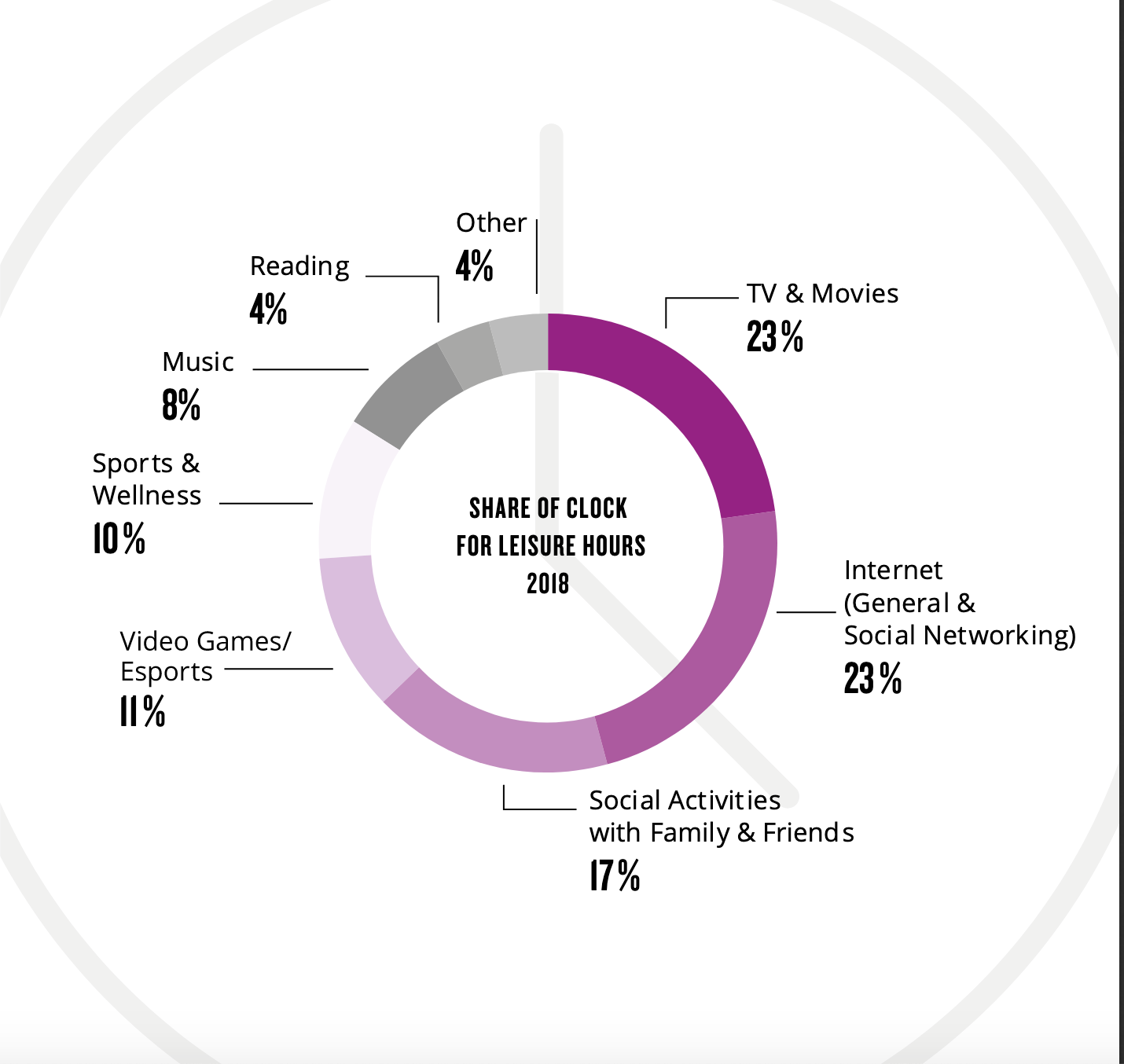Gaming is no longer a pastime for nerds in the basement; it is a force to be reckoned with. With 2 Billion players worldwide and two thirds of the U.S. population aged 13 and older claiming gamer status, it has undoubtedly become mainstream. With its powerful scale, gaming is giving the world of sports and entertainment a run for its money, upping the competition through innovation and deeper levels of accessibility, connectivity and interactivity.
But, first, who REALLY plays games? Twitch commissioned a study in 2014, which revealed that gamers are actually more social, family oriented, educated, optimistic, successful and socially conscious than non-gamers. They’re also nearly an even male/female split. Sure, gamers do skew younger but the older age groups are close behind. 43% of gamers are 36 or older. According to Nielsen, they spend more time with video games/esports than with sports & wellness, music or reading. Has the stereotype in your head changed yet?
And how did gaming get so big? There are MANY reasons for this, but today we’re going to dive into a few key players contributing to gaming's popularity—Twitch, esports and Fortnite.
Twitch is the Amazon-owned site/app where people watch other people play video games across the world. Twitch has 140MM unique visitors each month, and racked up a total of 949MM hours streamed in January alone (that’s around 108,000 year’s worth of hours in one month). In each stream, there are also chat rooms where viewers can connect with each other and cheer on their favorite player/talk smack.
Because Twitch is a global platform and accessible across all devices, it has contributed to catapulting esports into the limelight. Esports is defined as a multiplayer video game played competitively for spectators, typically by professional gamers. Esports viewership is expected to hit 84MM by 2021, surpassing all other U.S. professional sports leagues besides the NFL. And it's no joke; the largest prize pool recently hit an all time high of $100MM.
And finally, Fortnite. With 200MM players worldwide and 80MM monthly users, Fortnite has bridged the gap between hardcore and casual gamers. From its colorful, non-realistic visuals, to the lack of blood and gore, to the battle royale gameplay, it makes the game feel more inclusive and less daunting from the start.
Gaming provides unparalleled accessibility on a global stage, a game for everyone and a team to root on, so it's no surprise how quickly it's gone mainstream.
But why the hell do people like watching people play video games??
Many are baffled by Twitch, but think about it; we watch other people play sports, make food, travel, do their makeup, Marie Kondo their closets and everything else under the sun, so why not watch people play video games?
When surveyed, the top reasons people like watching esports look very similar to why people watch “real” sports - skill of players and excitement of the game. But what's interesting is that esports also offers things that aren’t typical for traditional sports. For example, “I like the different personalities of the players”, “I feel like I am playing along myself” and “I can comment in real-time during the games”. Sure, you can follow athletes on social and watch every interview that exists, but you don't get to know their personalities as well as gamers. AdAge said, “Players don't just stream their games on Twitch, they interact directly with fans via a live chat that runs beside the video." With gaming, you're able to have 1:1 conversations with your favorite stars and listen to their stream of consciousness as they play.
Gaming provides a next level of connectivity between fans and players that sets it apart from other sports.
So, how has gaming changed the sports and entertainment landscape?
Gaming has revived some forms of traditional entertainment. Esports stadiums are being built, movie theaters are finding new purpose, TV networks are vying for the rights to air tournaments and brands are gobbling up sponsorships.
Gaming has infiltrated pop culture through mashups of epic proportions. Celebs were quick to jump on the Fortnite bandwagon (or school bus in this case), with worlds colliding across rap, sports and gaming. The magic that ensued from Drake and Ninja’s battle was one for the books. MLB teams are playing it in their stadium and many NFL players' touchdown dances are inspired by Fortnite.
Gaming has opened up Pandora's box of virtual entertainment, pushing the limits of creativity, interactivity and opportunity. Can you imagine watching a concert inside a video game via your personalized avatar? Well Marshmello just did that in Fortnite, playing a virtual concert that 10MM people watched concurrently. For context, many prime TV shows don’t get that level of viewership. And this wasn't the first time a virtual concert took place; “Coalchella” music festival happened inside of Minecraft. What other crazy things can happen in a virtual world? The implications for marketers are wild.
Gaming has stolen Millennial hearts from traditional sports. The 18-25 year old segment is already watching gaming and esports more than traditional sports, and the 26-35 year old group isn’t far behind. Additionally, half of 18-25 guy gamers say they would quit their job to become a professional gamer if they could make it financially. Is this the new American dream?
How is everyone else trying to keep up?
Netflix understands the power of interactivity and is setting the stage for new viewing experiences. It’s no surprise that people loved the Black Mirror choose your own adventure TV show, Bandersnatch. With over a trillion different permutations of the narrative and five main outcomes, no two experiences were the same. Netflix is more than keeping up; viewers watch 1B hours of content per week and subscribers continue to grow.
The NBA understands the power of connectivity and is changing how we experience sports. While NBA viewership is not as high as the NFL, their social footprint is larger than any other league. And this was on purpose. Adam Silver, NBA commissioner, recently said, "We promote the posting of our highlights...We believe that greater fan engagement through social media helps drive television ratings.” Sporting News and WashPo explain that, "While other leagues jealously guard their video highlights, the NBA strongly encourages the sharing of its clips on social media. So-called 'NBA Twitter' has become a sports bar that doesn't close, a barbershop with unlimited seating, a family cookout where the NBA stars show up to hang."
Bleacher Report understands the power of infiltrating pop culture through mashups. Reporting from the "bleacher" about sports culture versus hardcore sports stats has always been their core mission, and the importance of this only increases as sports and pop culture continue to converge. With their smash hit video series Game of Zones, an animated spoof mashing up NBA players and Game of Thrones, they're harnessing the power of pop culture and it's paying off. Although their monthly visitors are lower than ESPN's, their social video views are 3x higher than ESPN, Complex and Vice.
More proof that the NBA is on the right track is seen in their data (*You heard it here first, thank you B/R for the custom data*). 63% of B/R's social engagements in 2018 were related to NBA content, and even during the off season, the NBA accounts for 47% of their social engagements, which is more than MLB, NFL, CFB and World Football combined. Their best day ever for global site visits wasn't the Super Bowl or NFL Draft, it was the day LeBron announced his intention to play for the Lakers (16.5M visits). Dang!
What does this all mean? Gaming's innovation is changing consumer expectations for all forms of entertainment through its next level accessibility, connectivity and interactivity. From a marketing perspective, every brand should have a gaming strategy at this point. Additionally, we should be asking ourselves how our brand can develop deeper, 1:1 connections with fans, how to make our product readily available any time and anywhere and how to create experiences with our brand that consumers can't find anywhere else.




